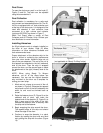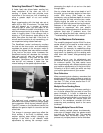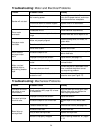
19
1. Repeat “Tension Roller Alignment” except
raise the sanding drum only 1/4 turn of the
height adjustment handle.
2. If both tension rollers are causing snipe then
tighten all four hex nuts (E, Figure 24) at this
position.
3. If only outfeed tension roller causes snipe,
only tighten rear (outfeed) hex nuts on each
end of drum at this position, then raise
sanding drum another 3/4 turn of the handle.
4. Press infeed tension roller down to rest on
conveyor bed and tighten front (infeed) hex
nuts at this position.
This process sets the tension roller assembly at
an angle providing less tension pressure on the
outfeed roller.
Drum Height Control Adjustment
If the height control mechanism does not
operate easily or smoothly, or there is excessive
vertical movement or deflection of the drum
carriage, perform the following adjustments.
1. Tighten all four lock nuts (A, Figure 26) and
then loosen them 1/8 to 1/4 turn. If the lock
nuts are set too tight, height control will not
operate easily. If the lock nuts are too loose,
excessive deflection of the outboard end of
the drum carriage will result.
2. Thoroughly lubricate the mating surfaces of
the motor mount slide (B, Figure 26), and
the height adjustment screw (C, Figure 26).
Figure 26
Operation
Before using your drum sander, review the
previous pages in this manual on initial set-up
and adjustment. In this section, you will learn
how to operate the machine. Make sure an
abrasive strip is mounted and a proper dust
collection system is connected.
Basic Operating Procedure
1. Set depth of cut.
2. Start dust collection system.
3. Start drum.
4. Start conveyor and select feed rate.
5. Feed stock through machine.
To feed stock through the sander, rest and hold
the board to be sanded on the conveyor belt,
allowing the conveyor belt to carry the board into
the drum. Once the stock is halfway through,
reposition yourself to the outfeed side of the
machine to receive and control the board as it
exits.
Setting Depth of Cut
Adjusting the drum sander for the proper contact
between the abrasive and the stock determines
the depth of cut. The depth of cut is controlled
by the height adjustment handwheel.
It may take some experimentation to determine
the proper depth of cut, given the variables of
abrasive grit, type of wood, and feed rate. For
best results, use scrap wood to practice sanding
and to develop skill and familiarity with the
machine before doing finish work.
A combination of several variables will
determine the proper depth of cut to use,
including the following:
1. Abrasive type and grit size.
2. Width of the piece being processed.
3. Hardness of the piece.
4. Feed rate of the conveyor belt.
Establishing Proper Drum Height
A good rule of thumb when sanding with grits
finer than 80 is to place the stock to be sanded
under the drum and lower drum until it contacts
the stock. Drum should still rotate by hand.
Without changing drum height, finish feeding
the stock under the sander.
Start sanding drum and sand the stock at that
same position.
Do not start drum while in
contact with stock!
For sanding with grits coarser than 80, you can
raise the conveyor table slightly.
Always maintain control of stock. Through
practice you will learn the proper depth of cut
considering the variables above.


















